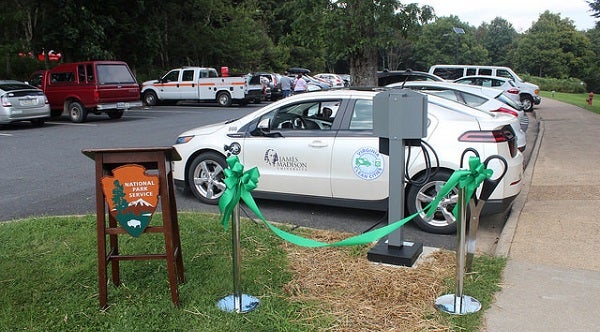(Electric) car talk with Virginia Clean Cities

Many consider electric vehicles (EVs) to be a ‘game changing’ technology because of their high performance, lower maintenance costs, and ability to be ‘fueled’ with solar energy. EV drivers are able to “fill up” for $1/gallon or less and can pair solar installed on their homes or businesses to generate their own fuel.
“Electric vehicles are an emerging market,” said Alleyn Harned, Executive Director of Virginia Clean Cities. “There are electric vehicles made by every major auto manufacturer. There is a vibrant used market. People are buying electric vehicles for under $8,000.”
Virginia Clean Cities is the commonwealth’s alternative fuel coalition. It works to expand access to electric vehicles and grow Virginia’s electric vehicle infrastructure. Harned believes expanding this infrastructure and educating consumers is key to growing the Virginia market for electric vehicles.
Harned also addresses some of the misconceptions around EVs, noting they typically perform better than gas vehicles. With new models offering over 200 miles of all electric range, ‘range anxiety’ is becoming a thing of the past.
Still, when to charge your EV is an important consideration. “EVs will charge at home 60% of the time,” Harned said. “We need more capacity for electric charging around the state.” Destination chargers’ at Virginia hotels, restaurants, and shopping centers can provide more opportunities for EV owners to charge and attract customers to those locations. Virginia Clean Cities provides support for businesses that want to add electric chargers to their workplace. It provides organizations with project technical information and can identify additional contacts or funding. It also partnered with VA SUN as part of the Mountain and Valley Solar Co-op.
Harned noted that solar and electric vehicles are a natural fit.
He said that electric vehicles travel 3-4 miles for each kilowatt-hour of energy produced. Even a small residential solar system of 3 KW (roughly 11 panels) produces enough power to drive an EV 11-12,000 miles annually. He advises using this figure when sizing out your solar system.
“As the market for solar expands, so does the market for electric vehicles,” Harned said. He noted the adoption path for EVs and solar is similar. People with EVs provide a real-world demonstration that the technology is a smart choice and spread that knowledge to friends and neighbors, just as people who have gone solar can show the benefit their system provides.
